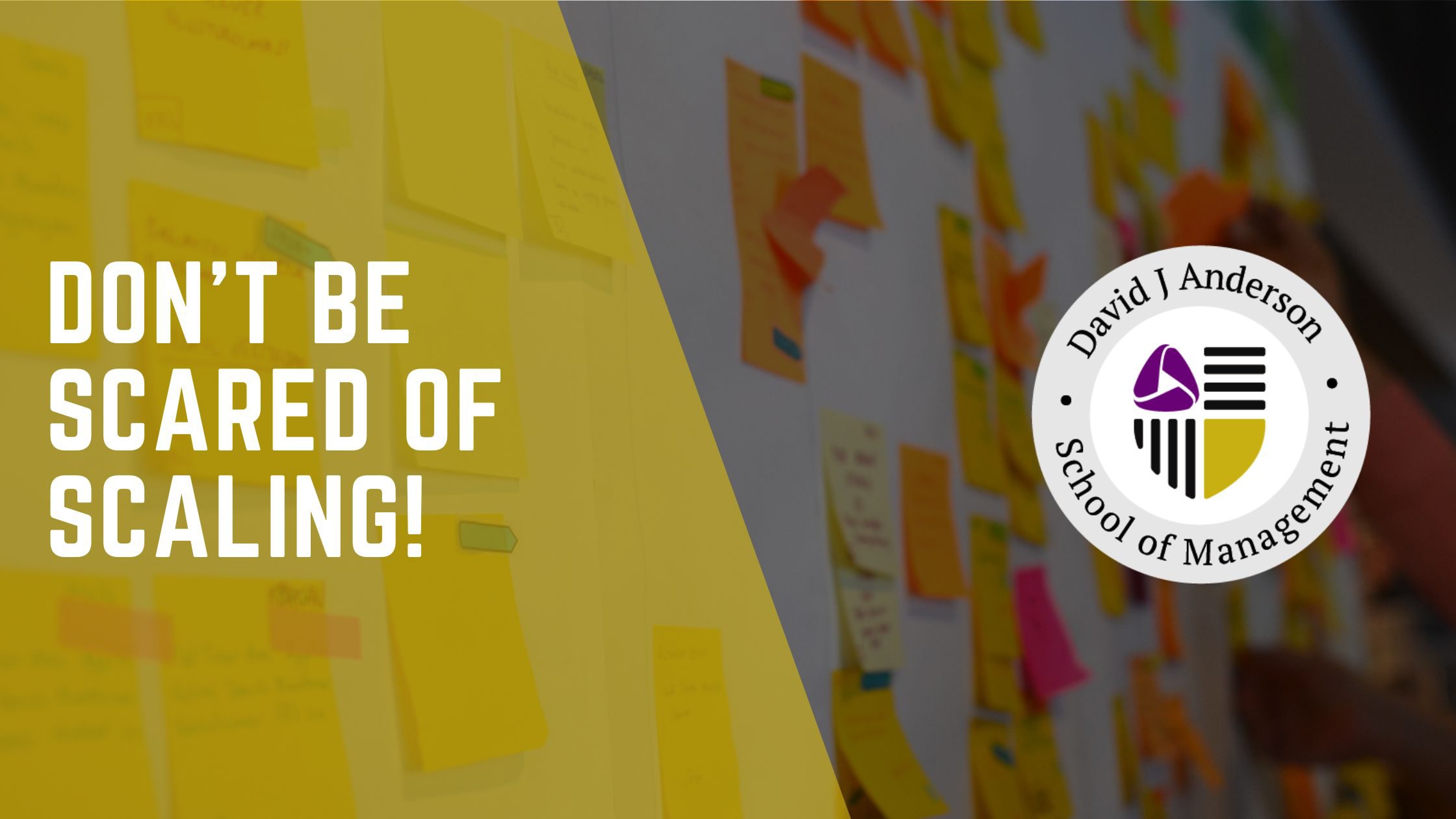Kanban – The Almost Free Alternative Path to Agility
Article 2 of the Enterprise Agility Without the Overheads Series
Implementing Kanban costs less than 1% of Agile methods and produces significant tangible business benefits.
On 24th December 2015 I met with the CTO of a large Chinese bank based in Shenzhen. He told me that in 5 months, he’d managed to scale Kanban to 2,000 people across 5 locations in China. That the adoption had institutionalized and he’d been able to tour the various locations and inspect many of the Kanban implementations for himself. The consultant told me that Kanban was producing greater productivity and efficiency than Scrum. He, however, didn’t elaborate much and wasn’t ready to share his data. Instead, he wanted more evidence before going public. He was, however, willing to share that the Kanban implementation had been achieved with 200 days of training and consulting and no coaches, just his people taking responsibility and showing accountability. Later he sent a team to our 2016 conference in San Diego who delivered a professionally made mini-documentary showing their journey and the value Kanban had delivered for them. It was, however, entirely in Chinese and without subtitles.
Their experience showed that in one day of billable time, Kanban had institutionalized 10 employees. Meanwhile, in another part of their business, Scrum coaching costs 180 days for every 12 employees. The CTO also confirmed that Scrum failed to institutionalize and required constant coaching. I hear this again and again from clients year after year. When they take the Agile coaches away, Agile practice adoption deteriorates.
To put this in perspective, in terms of per-employee adoption cost, Kanban was costing this bank 1/150th of the cost of Scrum and producing better results.
How might this huge cost saving be possible?
For starters, Kanban doesn’t require you to add people to your organization as coaches or product owners. Instead, it provides existing workers the means to frame problems and make better quality decisions. Kanban is empowering and enabling. Workers become more effective at doing their existing jobs in the existing process and workflow. There is no need for coaching in a new role as part of a new process. It is simply more effective to stick with what you do now and get better at it than it is to make grand changes.
In July 2020, I spoke with an Agile coach from New Zealand, she told me that she applies for ScrumMaster positions, and then when she gets on the ground, she offers the organization some options, ¨alternative paths to agility¨ if you like. She stated that organizations running side-by-side experiments choose Kanban, while some decide to adopt it after learning about the options. Additionally, she asserted that Kanban becomes institutionalized, whereas she has observed numerous instances where organizations remove Scrum coaches to save money or because they consider the Agile transition “complete,” only for it to unravel once the coach is gone. However, Kanban is proving much more effective for her. In 2020, customers were not yet ready to openly purchase it. Instead, they followed the trend and bought into Scrum, requiring a later shift in mindset.
Scrum is a Procrustean Bed
Coming back to December 2015 before I visited China, I was in India where I saw a case study presented by a young consultant who was acting for a large Agile (American) consulting firm. He was advising a large Indian outsourcing firm, who in turn was the off-shore supplier for a large financial institution based in New York, the credit card company that used to ask us “Do you know me?”. The client adopted Scrum largely enterprise-wide and adjusted all their processes to facilitate a 2-week Sprint cadence. This change happened on a mind-boggling scale of 100,000 people. They asked an entire financial institution to synchronize its business practices to facilitate the IT organization’s adoption of Scrum and 2-week sprints.. If there ever was evidence that Scrum is a Procrustean Bed that forces you to change to it, rather than helping you change and improve, then this experience report provided prima facia evidence.
Managing the Transition
Despite the painful disruption, they had, by all accounts, managed this transition. 100,000 people are now in lock-step on a 2-week cadence feeding the sprints. However, actual customer (business owner request) lead times for changes to credit card processing systems were taking 130 days on average, not a couple of weeks as might be expected from an Agile organization. With some courage, the consultant took it upon herself to push through a single kanban system implementation. With no other changes, they reduced lead times to just 12.5 days within 6 weeks, and the client was so pleased that they urged the consulting firm to implement more Kanban. That particular consulting firm was well known to be anti-Kanban and their salespeople worldwide were known to actively dissuade clients from experimenting with it. They had the tools to sell Scrum and they wanted their clients to buy Scrum. To consider any alternative was a threat to revenues and sales commissions. So, it took a courageous act from a single professional keeping the clients’ best interests at heart while putting her continued employment in jeopardy to create a huge improvement in value delivery.
Kanban has consistently shown tangible economic benefits.
That same week in India I saw another presentation from Amit Kaulagekar of FiServ who had been working with SunGard. Their kanban system produced a 30% increase in revenue by enabling the firm to process more service requests faster and consequently increase their client base. This is real ROI.
If this implementation cost 14% of OpEx like a typical Agile implementation, would you rationally spend 14% more on OpEx to get 30% more revenue? Probably not! Revenue isn’t margin or profit. It would depend a lot on how big your margins were and how much additional free cash these improvements generated. Equally, you cannot know the improvement in advance, so what´s the risk premium? If you felt there was a 30% probability of a 30% increase in revenue, then you would discount that expectation to just 9%.
This SunGard story makes sense only because implementing Kanban cost them almost nothing. They only paid the consulting fee for Amit from FiServ. This Kanban implementation cost a handful of coaching days over 6 months. At the cost of Kanban, these benefits make real sense; they make a difference. Meanwhile, at the cost of Agile, the unlikely outcome that you might produce such benefits simply is not worth the risk. It is irrational to spend money on Agile transition initiatives.
Increased revenue by 30% in only 5 months
Amit´s story provided a déjà vu moment. I recollected another case study presented at Lean Kanban Benelux some years earlier by Tina Dudenhoeffer, a consultant, and Marianne Lanting of Winkle, a market research agency in the Netherlands. Again, they increased revenue by 30% in only 5 months by servicing requests for market research surveys faster and more predictably using Kanban. The cost of this implementation was less than 20 consulting days from Tina plus training from Maarten Hoppen of our partner training organization, VX Company. Marianne was a manager at Winkle and required no additional cost. Once again, with the low costs of Kanban, the benefits made a real impact on Winkle. Marianne claimed that the changes had saved the company from bankruptcy.
In general, these results, while they may sound extreme to many readers, are not surprising. We already know from surveys and reports that our training is more effective than typical Agile training. Kanban training is specifically experiential and uses games, simulations, and exercises that simulate or model the actual working environment. Students leave our classes with specifically actionable ideas and designs for changes, many of which they can implement immediately at no or very low cost. There is usually no need to ask for additional budget or even permission to get started. The changes implemented do not require much coaching. Students leave our classes understanding what to do and why they want to do it.
Kanban coaching engagements, from a firm with Accredited Kanban Consultants (AKCs) or Kanban Coaching Professionals (KCPs), will typically involve 2-4 days per month for organizations up to a product unit (or 150 people) in size. Kanban coaching is typically centered around coaching managers on metrics, reporting, and implementing effective feedback mechanisms such as Service Delivery Review, Risk Review, or Operations Review. The Kanban Method focuses on catalyzing leadership through accountability.
Carpe Diem! It’s time to put Agile in the bin and move on.
2024 is yet another challenging year in a decade where we’ve experienced a pandemic, an economic crisis, rampant inflation, war, more war, and constant geopolitical uncertainty. Businesses are scared of an uncertain future and budgets are locked down. The Agile crisis is upon us. For more than a year already businesses worldwide are cutting Agile roles. Every day you will find a new post on social media declaring “Agile is Dead” sparking numerous debates. Companies around the world are putting Agile in the bin. The question is, “What next?”. Fundamentally, enterprises need agility more now than ever. There is a proven and effective alternative path to agility, the Kanban Method. It has an extensive body of knowledge, including the Kanban Maturity Model and the Fit for Purpose Framework. It has a proven track record at scale – it offers Enterprise Agility without the Overheads.
Is now the time for you to start on your Kanban journey to true enterprise agility?
Contact us to get tailored recommendations for training for you and your organization. Discover our complete schedule of training courses designed to equip you with the tools needed to see similar results.
Enterprise Agility Without the Overheads
This is article two of our series Enterprise Agility Without the Overheads. Get caught up on article one.





